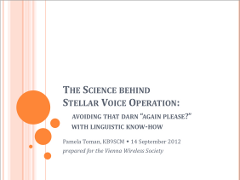
In noisy conditions on the airwaves, it can be hard to exchange information effectively. Rather than throwing more power or another $1000 of equipment at the problem, radio operators can often improve reception by adjusting the signal at its source: their articulatory organs. By enunciating, focusing on vowels, using recognized phonetic alphabets, and matching listeners’ expectations about pitch, amateur radio operators can effectively boost the quality of their signal.
To download the presentation in .pdf format, click on the image at right or the preceding link.
Context for Non-Hams
Relevance of Amateur Radio
Since the 1960s and 1970s, public interest in amateur radio has waned as reliable mobile communication has become available for minimal cost. Our dependence on such systems, however, has left us increasingly vulnerable to natural and man-made disasters. When the communication infrastructure is destroyed or severely overloaded (such as the 2011 Japanese earthquake and tsunami, Hurricane Katrina, the Marine Corps Marathon, and presidential inaugurations), hams continue to provide robust, decentralized communication.
Beyond practical uses, ham radio is also a hobby like any other, worthwhile for the enjoyment it brings.
“Noise” on the Air
The amateur radio bands do not always provide a perfect channel for communication. In especially bad conditions, trying to understand a message can be akin to listening to shouting from half a block away, on a windy day with city traffic. Although some atmospheric and noise conditions are uncontrollable, amateur radio operators do our best to produce cleanly intelligible signals, and we hone the skills required to understand content despite bad conditions.